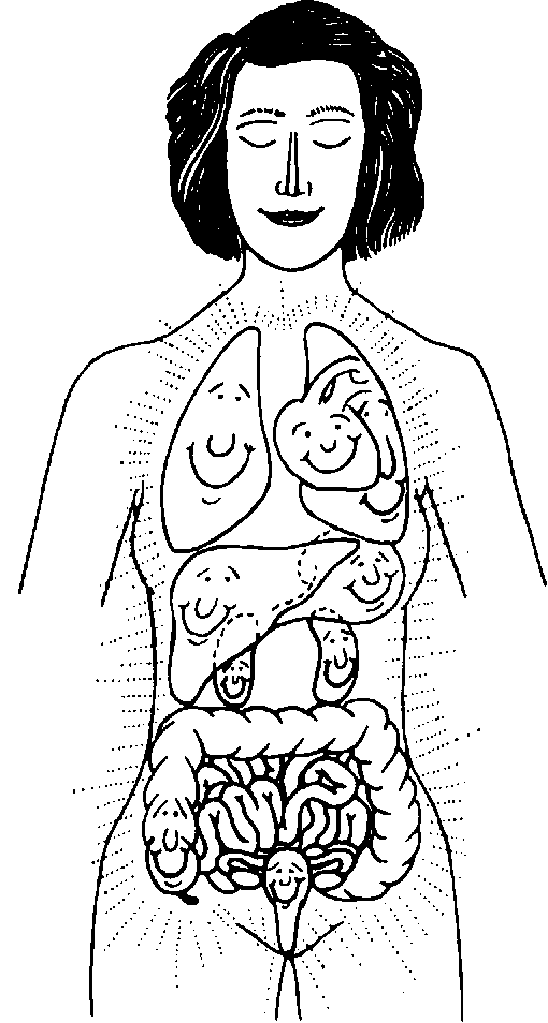[This is part of BFNow Self-Study Module 1: Self-Awareness and Self-Compassion. For more about the overall Self-Study program, please look at About BFNow Self-Study and BFNow Self-Study Orientation.]
This is your first Bright Future Now exploration page with the Inner Smile exploration inspired by Mantak Chia’s Taoist Inner Smile practice.
Before going further, let me encourage you to pause, relax and release your cheeks and do three deep breaths.
The basic idea is to smile “to” one of your organs, like your lungs or your heart, and feel your organ smiling back to you. The full Taoist practice steps through all the major organs but we’ll keep it simple. You only need to smile to one organ although you are welcome to do as many as you like.
Here’s an image to give you a feel:
Inner Smile
This experience can increase your awareness of your body and boost your immune system, and is one of the nicest, most appropriate forms of self love I know. It’s valuable Optimal Zone hygiene. It is also something we will build on for the rest of this week.
Experiential
Here’s how you do it:
Sit or lie comfortably
Evoke a smile of happiness. Lift your cheeks a few times to stimulate and loosen your smile muscles and think about something pleasant that evokes a warm smile.
Staying with that smile feeling, close your eyes and direct your attention into your body to the organ of your choice.
Smile to that organ. You might want to think about all that organ does to support your life 24 hours a day, 7 days a week, 365 days a year. If you feel some gratitude, you might want to send a feeling of appreciation along with your smile.
Give yourself at least three minutes to settle in to happily smiling with appreciation
Allow yourself, as you do this, to feel your organ smiling back to you.
For the moment, allow yourself to feel the feelings that seem to be flowing between your conscious self and your organ.
When you feel that the experience is complete, thank your organ, open your eyes and take a few easy deep breaths
What was your experience like? Make some notes in your journal as you reflect on your experience. (If you haven’t chosen a journal yet, today would be a good time to do so.)
Throughout your day, find at least two additional times when you can do this Inner Smile for other organs. This is important to anchor the experience and see that it can be woven into your life.
Add some more notes in your journal at the end of the day.
If you have questions or comments, please post them here.
Thanks!
Robert
[Link back to the Module 1: Self-Awareness and Self-Compassion Overview page.]
PS - Your Optimal Zone
One of the big influences on this week’s explorations is the wonderful progress over the past few decades in learning how to heal emotional trauma. Another related one is couples therapy. Both of these point to the importance of learning how to get into what we’re calling your Optimal Zone – and act from there even in the face of discomfort – to facilitate both internal and relational healing.
How do you know if you’re in your Optimal Zone? It’s an experience, not a definition, so words can only provide pointers. The Inner Smile exploration is intended to get you into the experience without having to think a lot about it – but its only part of the story.
So I’d like to supplement that with some characteristics drawn from the Internal Family Systems approach. They describe the qualities of the Optimal Zone (which they call the Self experience) in terms of 8 C’s:
curiosity
calm
clarity
connectedness
confidence
courage
creativity
compassion
When you do an Inner Smile, you might gently check to see if you feel any of these qualities.
You’ll find Optimal Zone Qualities.docx with these 8 C’s here. I encourage you to print it out (or make up your own) and post it somewhere that you’ll regularly see it as support for connecting with your Optimal Zone.


